To determine the best turbine location, you'll need to evaluate several key factors. Wind speed and consistency are essential, with ideal average speeds of at least 13 mph at turbine height. You must assess terrain and obstacles that could affect wind flow, while adhering to local zoning regulations. Environmental impact, proximity to power grids, and noise considerations are significant. Don't forget about soil stability for proper foundation support and accessibility for installation and maintenance. A thorough cost-benefit analysis will help you weigh these factors. By carefully evaluating each aspect, you'll be well-equipped to make an informed decision on ideal turbine placement.
Wind Speed and Consistency

Consistently, wind speed and consistency rank as the most essential factors when determining the best location for wind turbines. You'll want to seek areas with average wind speeds of at least 13 mph (21 km/h) at turbine height. Higher wind speeds translate to more energy production, making your investment more profitable.
It's not just about high speeds, though. Consistency is equally important. You're looking for locations with steady, reliable winds throughout the year. Avoid areas prone to long periods of calm or extreme fluctuations in wind patterns. Coastal regions, open plains, and mountain passes often offer the ideal combination of speed and consistency.
To assess a site's potential, you'll need to conduct wind resource assessments. This involves collecting data over an extended period, typically a year or more, using meteorological towers or LiDAR technology.
These measurements will help you create wind rose diagrams and understand the prevailing wind directions, which are vital for favorable turbine placement and orientation.
Terrain and Obstacle Assessment

When evaluating potential turbine locations, you'll need to take into account the terrain and obstacles that could affect wind flow.
You should conduct a topographical impact analysis to understand how the landscape shapes wind patterns and identify any obstructions that might disrupt airflow.
Additionally, you must evaluate the site's accessibility and construction feasibility, ensuring that the terrain allows for efficient turbine installation and maintenance.
Topographical Impact Analysis
Topography plays a crucial role in determining the ideal location for wind turbines. When analyzing the topographical impact, you'll need to evaluate how the land's shape and features affect wind flow and turbine performance.
Hills, valleys, and ridges can considerably influence wind patterns, creating acceleration or turbulence that impacts energy production.
To conduct a thorough topographical impact analysis, you should:
- Use digital elevation models (DEMs) to create detailed 3D maps of the area
- Analyze slope angles and orientations to identify best turbine placements
- Assess the potential for wind funneling effects in valleys or between hills
- Evaluate the risk of turbulence caused by abrupt changes in terrain
Wind Flow Obstruction
Obstacles and terrain features can considerably impede wind flow, affecting the performance of wind turbines. When evaluating potential turbine locations, you'll need to carefully examine the surrounding landscape for any obstructions that might disrupt wind patterns. These can include natural elements like hills, cliffs, and dense forests, as well as man-made structures such as buildings, towers, and other wind turbines.
You'll want to identify and map out all potential obstacles within a significant radius of your proposed turbine site. Pay special attention to the prevailing wind direction, as obstructions upwind can create turbulence and reduce wind speeds reaching your turbine.
It's essential to take into account the height of these obstacles relative to your planned turbine height. Generally, you'll aim to position your turbine at least two to three times higher than any surrounding obstructions.
Don't forget to account for seasonal changes in vegetation. Deciduous trees, for instance, may present different levels of obstruction throughout the year. You should also think about future developments in the area that could potentially impact wind flow.
Accessibility and Construction
Terrain challenges and accessibility concerns play an essential role in determining the feasibility of wind turbine construction. You'll need to take into account the topography, soil conditions, and existing infrastructure when selecting the best location for your wind turbines. Steep slopes, unstable ground, or areas prone to flooding can greatly increase construction costs and complexity.
Access roads are critical for transporting heavy equipment and turbine components to the site. You'll want to evaluate the existing road network and determine if new roads need to be built or existing ones upgraded. Remember that these roads must be able to support large trucks and cranes.
When evaluating potential turbine locations, keep in mind:
- The need for a stable foundation to support the turbine's weight
- Proximity to electrical grid connection points
- Environmental impact and potential habitat disruption
- Local zoning regulations and permitting requirements
You'll also need to think about the logistics of construction, including the availability of skilled labor, equipment, and materials in the area.
Local Zoning and Regulations

Compliance with local laws is vital when selecting a turbine location. You'll need to research and understand zoning regulations, land use restrictions, and permitting requirements specific to your area. These rules can vary greatly between jurisdictions, so don't assume what's allowed in one place applies elsewhere.
Check if your chosen site is zoned for wind energy development. Some areas may have height restrictions that could limit turbine size.
You'll also need to take into account setback requirements, which dictate how far turbines must be from property lines, roads, and buildings.
Environmental regulations play an important role too. You may need to conduct impact studies on wildlife, noise levels, and visual effects. Many localities have specific noise ordinances that turbines must adhere to, especially in residential areas.
Don't forget to investigate any historical or cultural preservation laws that might affect your site. Some areas protect viewsheds or have restrictions on development near landmarks.
Lastly, be aware of any aviation regulations. If your site is near an airport or in a flight path, you'll need to comply with FAA guidelines and possibly obtain clearance for your turbine's height and location.
Environmental Impact Considerations
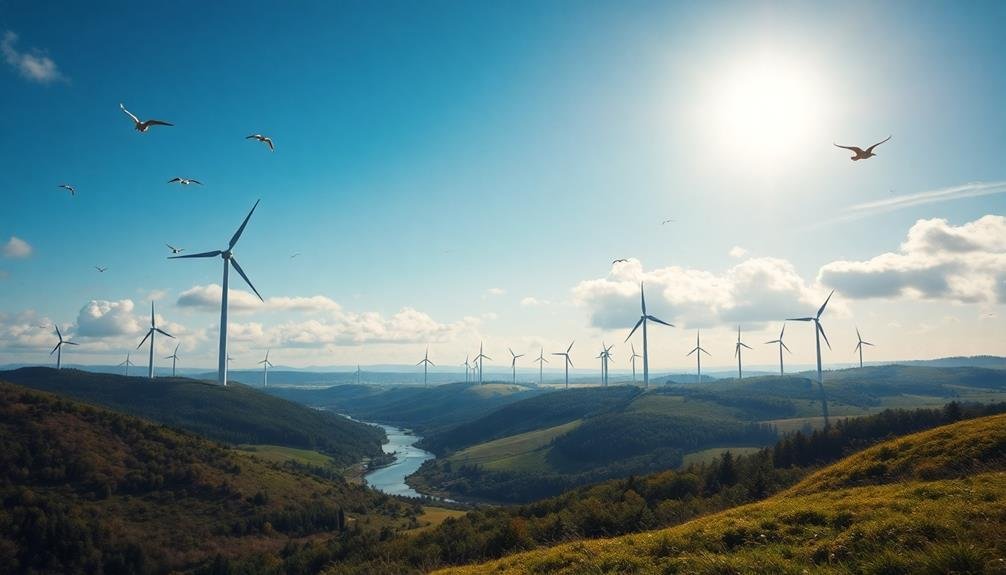
While selecting the ideal turbine location, you must carefully consider its potential environmental impact. Turbines can affect local ecosystems, wildlife, and landscapes, so it's essential to assess these factors before making a decision.
You'll need to conduct environmental impact studies to identify potential risks and develop mitigation strategies.
Consider the following environmental factors when choosing a turbine location:
- Wildlife habitats: Assess the area for endangered species, bird migration routes, and bat populations.
- Noise pollution: Evaluate the turbine's noise levels and their impact on nearby residential areas.
- Visual impact: Consider how the turbine will affect the landscape and local aesthetics.
- Ecological disruption: Analyze potential changes to soil, water, and vegetation in the area.
You'll also need to comply with environmental regulations and obtain necessary permits.
Work closely with environmental experts to minimize negative impacts and implement conservation measures.
Consider using technologies like bird detection systems or acoustic deterrents to protect wildlife. Additionally, you may need to conduct ongoing environmental monitoring to guarantee compliance and address any unforeseen issues.
Proximity to Power Grid
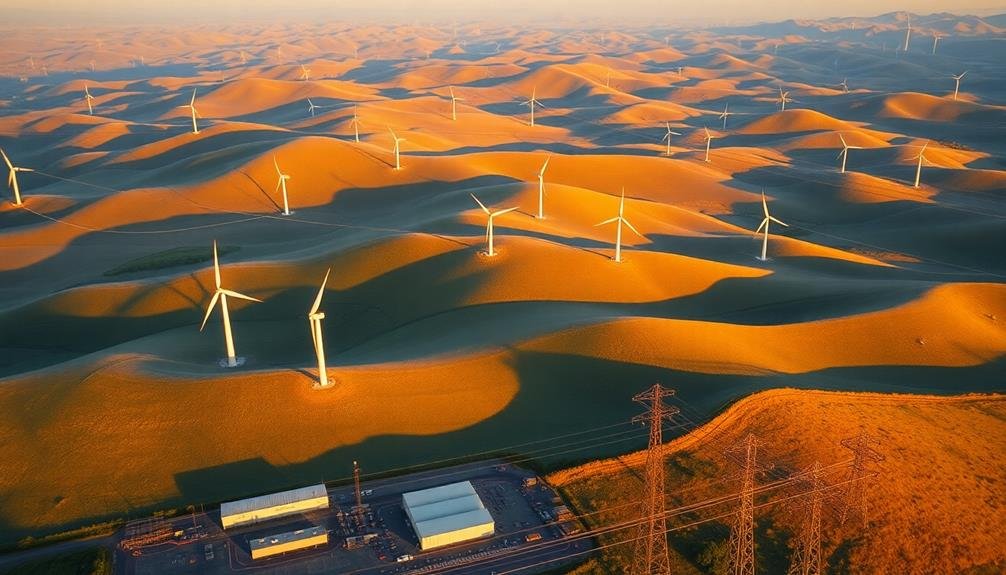
When it comes to turbine placement, proximity to the power grid is an essential factor you can't afford to overlook. The closer your turbines are to existing power infrastructure, the more cost-effective and efficient your project will be. You'll need to take into account the distance between your proposed turbine site and the nearest substation or transmission lines.
Shorter distances mean lower costs for connecting your turbines to the grid. You'll save on materials like cables and reduce power losses during transmission. It's also easier to maintain and service turbines that are closer to established infrastructure.
However, don't forget that the best wind resources mightn't always align with the closest grid connection points. You'll need to balance ideal wind conditions with grid proximity. Sometimes, it's worth investing in longer transmission lines to access superior wind resources.
Think about future grid expansion plans in your area, as they might influence your site selection. Always consult with local utility companies to understand connection requirements and potential upgrade costs.
Noise and Visual Impact
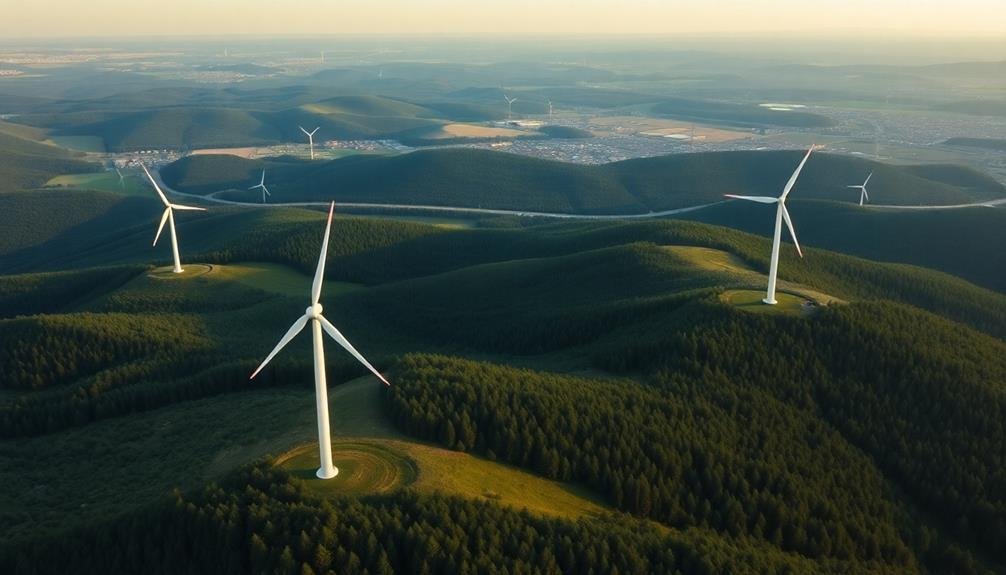
Although wind turbines offer clean energy, their noise and visual impact can be significant concerns for nearby communities. When selecting a turbine location, you'll need to take into account how the turbines will affect the surrounding area visually and acoustically.
Turbines can produce a low-frequency hum and occasional swooshing sounds, which may disturb nearby residents, especially at night. You'll need to assess the potential noise impact and guarantee compliance with local regulations.
Visual impact is another vital factor. Large turbines can alter the landscape dramatically, potentially affecting property values and tourism in scenic areas.
To minimize noise and visual impact, take into account these factors:
- Distance from residential areas
- Topography and natural barriers
- Turbine size and design
- Local zoning laws and setback requirements
You can use noise modeling software to predict sound levels at different distances and under various weather conditions.
Visual impact assessments, including photomontages and 3D visualizations, can help you understand how turbines will affect the landscape.
Soil Composition and Stability

Soil composition and stability play an essential role in determining the best location for wind turbines. You'll need to conduct thorough geotechnical surveys to assess the soil's characteristics and load-bearing capacity. Sandy or rocky soils are often preferred, as they provide better drainage and stability for the turbine's foundation.
You should avoid areas with expansive clay soils, as they can swell and shrink with moisture changes, potentially compromising the turbine's structural integrity. Similarly, locations with high water tables or prone to flooding aren't suitable due to the risk of soil erosion and foundation instability.
Consider the soil's depth to bedrock, as it affects the foundation design and construction costs. Shallow bedrock may require more expensive foundation solutions, while deeper bedrock allows for more standard foundation types.
You'll also need to evaluate the site's seismic activity and potential for soil liquefaction during earthquakes. Areas with high seismic risk may require additional reinforcement and specialized foundation designs.
Lastly, assess the soil's corrosiveness to guarantee the longevity of underground components. Highly acidic or alkaline soils can accelerate corrosion, leading to increased maintenance costs and reduced turbine lifespan.
Accessibility for Installation

When selecting a turbine location, you'll need to take into account site access challenges.
You must evaluate the existing roads, bridges, and pathways to determine if they can support the transportation of large turbine components.
If the infrastructure is inadequate, you'll have to factor in the costs and logistics of upgrading access routes or creating temporary roads to facilitate installation.
Site Access Challenges
Despite the potential of an ideal wind resource, site access challenges can make or break a turbine installation project.
You'll need to carefully assess the terrain and infrastructure leading to your chosen location. Steep slopes, dense forests, or marshy areas can considerably complicate the transportation of turbine components and heavy machinery.
Additionally, you must consider the width and weight capacity of existing roads and bridges.
If site access is limited, you may need to invest in temporary road construction or upgrades to existing infrastructure. This can add substantial costs to your project and extend the timeline.
In some cases, you might even need to explore alternative transportation methods, such as helicopters for particularly remote or challenging locations.
When evaluating site access, consider these key factors:
- Distance from nearest suitable road or port
- Terrain characteristics (slope, vegetation, soil stability)
- Weight and size restrictions on local roads and bridges
- Seasonal weather conditions that may affect access
Transportation Infrastructure Requirements
Adequate transportation infrastructure is vital for successful wind turbine installation. You'll need to guarantee that roads leading to the site can accommodate oversized vehicles carrying large turbine components.
These components, including blades, towers, and nacelles, often exceed standard transportation dimensions and weights. You must assess the route for potential obstacles like narrow bridges, low overpasses, or sharp turns that could impede transportation.
Consider upgrading existing roads or constructing temporary access roads if necessary. These improvements should support heavy machinery and cranes required for installation.
You'll also need to plan for staging areas where components can be stored and assembled before final placement.
Ports and railways may play a significant role in your transportation strategy, especially for offshore wind farms or remote inland locations.
You'll want to evaluate nearby port facilities for their ability to handle large turbine components and assess rail links for their capacity to transport heavy loads.
Lastly, don't forget to factor in local regulations and permits for oversized loads. You may need to coordinate with local authorities to guarantee smooth transportation and minimize disruptions to regular traffic flow.
Cost-Benefit Analysis
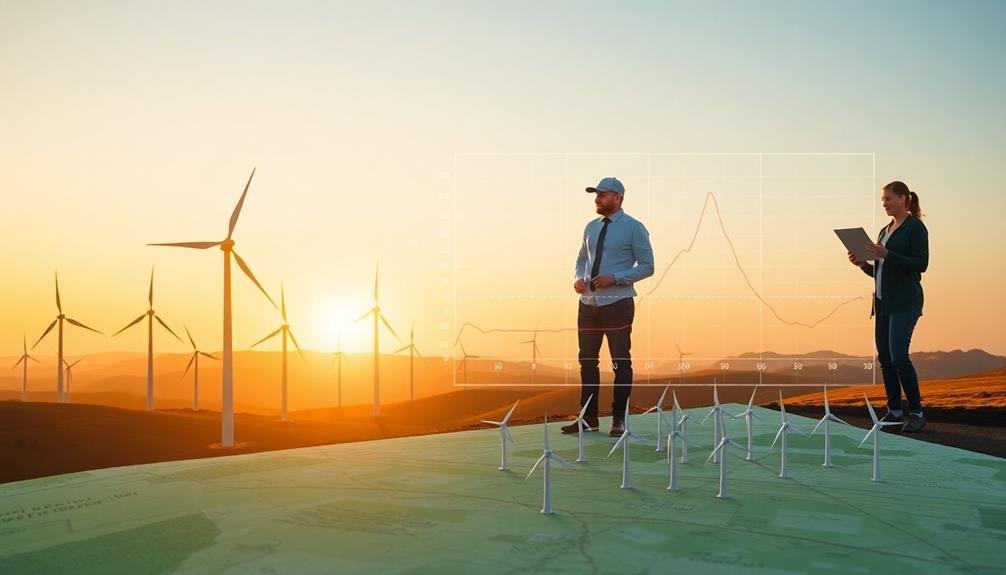
Conducting a thorough cost-benefit analysis is essential for determining the ideal turbine location. You'll need to weigh the potential energy output against the costs of installation, maintenance, and operation. Consider both short-term expenses and long-term returns to make an informed decision.
Start by estimating the energy production potential of each site. Factor in wind speed, consistency, and any potential obstacles that might affect turbine performance.
Then, calculate the costs associated with each location, including:
- Land acquisition or leasing fees
- Site preparation and infrastructure development
- Turbine purchase and installation expenses
- Ongoing maintenance and repair costs
Don't forget to account for potential revenue streams, such as power purchase agreements or renewable energy credits.
You should also consider the lifespan of the turbine and any future upgrades or replacements that may be necessary.
Frequently Asked Questions
How Long Does It Take to Install a Wind Turbine?
You'll find that installing a wind turbine typically takes 2-3 days. However, the entire process, including site preparation and connecting to the grid, can span several weeks or even months, depending on the project's complexity.
What Is the Average Lifespan of a Modern Wind Turbine?
You can expect a modern wind turbine to last about 20-25 years. With proper maintenance, you'll get the most out of your turbine. After this period, you'll likely need to replace or upgrade major components.
Can Wind Turbines Be Installed on Residential Properties?
Yes, you can install wind turbines on residential properties. You'll need to evaluate local zoning laws, available space, and wind conditions. Small-scale turbines are designed for homes, but they're most effective in areas with consistent winds.
How Much Electricity Can a Single Wind Turbine Generate?
You'll find that a single wind turbine's electricity generation varies widely. It depends on the turbine's size and wind conditions. Typically, you can expect anywhere from 2 to 10 megawatts for large turbines, or 2-10 kilowatts for small residential ones.
Are There Any Health Risks Associated With Living Near Wind Turbines?
You may experience some health concerns living near wind turbines. Noise, shadow flicker, and low-frequency sounds can potentially cause sleep disturbances, headaches, and stress. However, most studies suggest these effects are minimal for most people.
In Summary
You've explored the key factors for ideal turbine placement. Remember, wind speed and consistency are essential, but don't overlook terrain, regulations, and environmental impact. Consider the power grid's proximity, noise levels, and visual effects. Assess soil stability and site accessibility. Finally, conduct a thorough cost-benefit analysis. By weighing all these factors carefully, you'll be well-equipped to choose the best location for your wind turbine project.

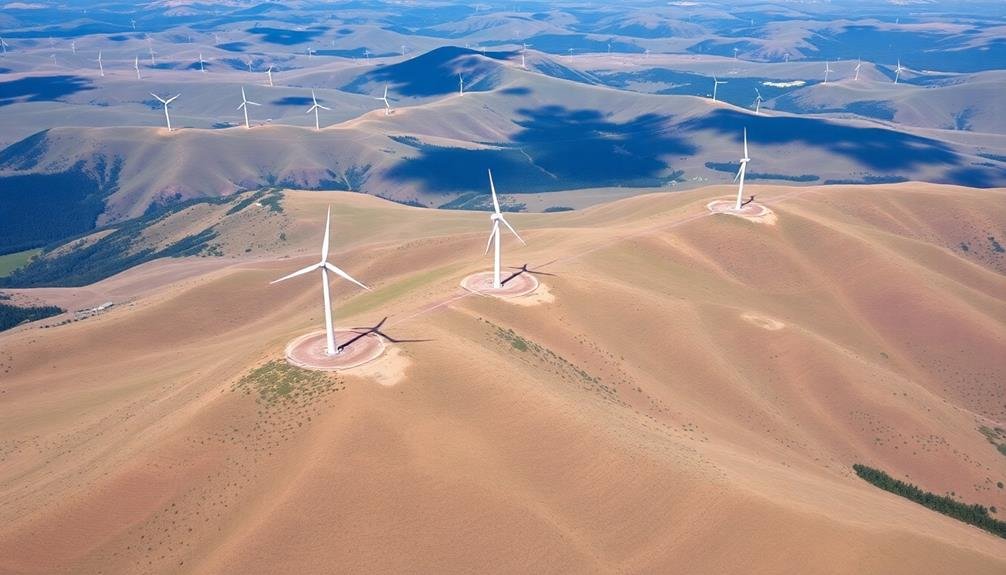



Leave a Reply